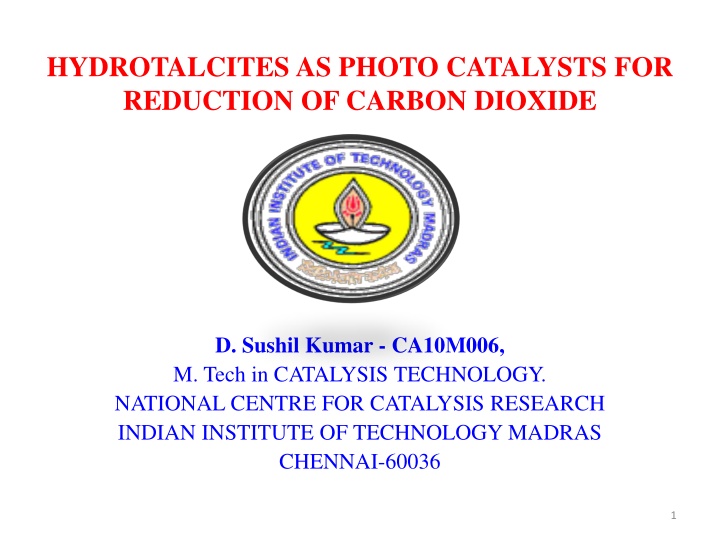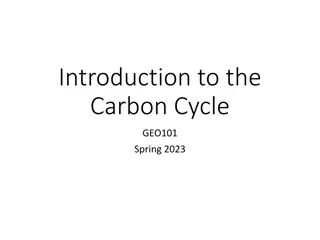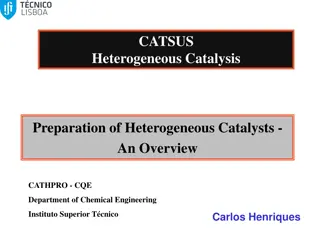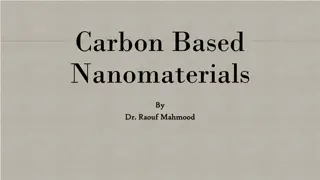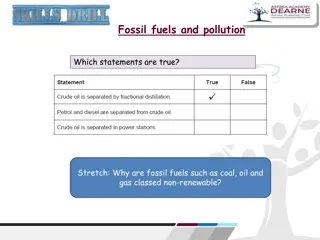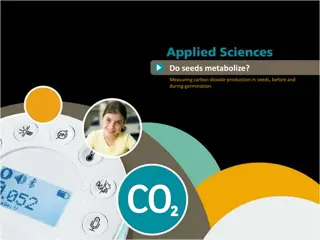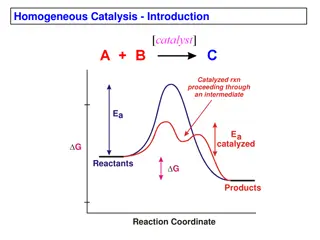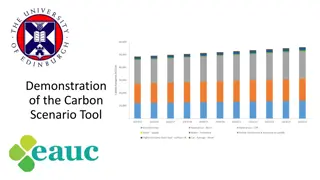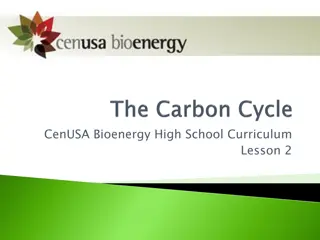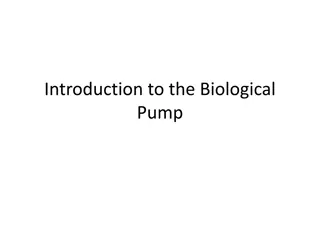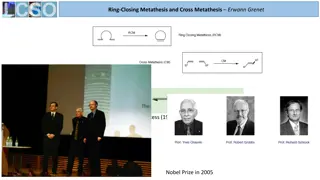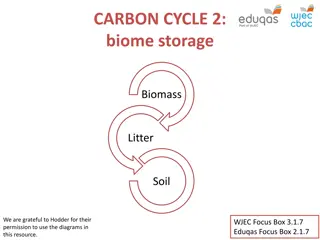Utilizing Hydrotalcites as Photo Catalysts for Carbon Dioxide Reduction
Burning fossil fuels leads to CO2 emissions, posing a significant environmental challenge. Converting CO2 into valuable hydrocarbons through photocatalytic reduction using solar energy provides a sustainable solution. This process involves multi-electron transfer steps, requiring efficient catalysts like hydrotalcites. The photo-catalysis approach offers a promising method for reducing CO2 emissions and producing renewable carbon fuels.
Uploaded on Sep 29, 2024 | 1 Views
Download Presentation

Please find below an Image/Link to download the presentation.
The content on the website is provided AS IS for your information and personal use only. It may not be sold, licensed, or shared on other websites without obtaining consent from the author.If you encounter any issues during the download, it is possible that the publisher has removed the file from their server.
You are allowed to download the files provided on this website for personal or commercial use, subject to the condition that they are used lawfully. All files are the property of their respective owners.
The content on the website is provided AS IS for your information and personal use only. It may not be sold, licensed, or shared on other websites without obtaining consent from the author.
E N D
Presentation Transcript
HYDROTALCITES AS PHOTO CATALYSTS FOR REDUCTION OF CARBON DIOXIDE D. Sushil Kumar - CA10M006, M. Tech in CATALYSIS TECHNOLOGY. NATIONAL CENTRE FOR CATALYSIS RESEARCH INDIAN INSTITUTE OF TECHNOLOGY MADRAS CHENNAI-60036 1
CONTENTS Introduction. Photo catalysis. Applications of photo catalysts. Importance of CO2 reduction. Features of photo catalysts Reaction pathways. Various catalysts used. Hydrotalcites. Structural features of HTC. Different types of HTC s. Aim & Scope. Experimental approach / Work plan. 2
Introduction Burning of fossil fuels causes emission of CO2 into the atmosphere and tackling this issue is a serious challenge. Of the several options available converting carbon dioxide into valuable hydrocarbons is the best solution . Generally CO2 conversion is by physico-chemical approach: sustainable (or renewable) synthetic methane, methanol, syngas production derived from flue gases from coal, gas, and photochemical production of synthetic fuels. Using renewable energy (solar energy) as the source to reduce CO2 emissions, could lead to lower the consumption of fossil fuels. Photocatalytic reduction of CO2 to solar fuels is a thermodynamically up-hill process that proceeds through multi-electron transfer steps and developing an efficient catalyst is the key issue http://www.lenntech.com/carbon-dioxide.htm. 3
Techniques for CO2 reduction Chemical The utilization of solar energy via chemical storage 1. photo catalytic or 2. photo-electrochemical activation of light- sensitive catalytic surface. photo-chemical bio-chemical bio-photochemical radio-chemical Photo catalytic system is the best electro-chemical electro-photochemical bio-photo-electrochemical 4
Photo catalysis Definition: catalyst can either absorb the light itself or harness the light absorbed by another molecule. The acceleration of a photo reaction in the presence of a catalyst . The Efficient solar fuel generation requires efficient - light absorption. - charge separation, and - use of the separated charges in fuel-forming reactions. These reactions must produce the desired fuel (e.g., H2, CH4,CH3OH) and a desirable co-product (e.g. O2 from water oxidation). Heterogeneous (Insoluble) catalysts: Using semi conductor, the Light absorption and Charge separation are implemented. Homogeneous(Soluble) catalysts: Using molecular assemblies in solution. Akira Fujishimaa, Xintong Zhanga, Donald. A. Trykb: J. of Hydrogen Energy 32 (2007) 2664 2672 5
Routes for renewable carbon fuels There are two conceptual routes to produce renewable Carbon containing fuels using solar energy. The direct photo reduction of CO2 using water as a reductant. The photolysis of water to generate hydrogen and further reaction of this hydrogen with carbon dioxide forming C1 C2 fuels. 6
Homogeneous catalytic CO2 reduction Catalysts used: mostly transition metal complexes (e.g., containing Ru and Ir) They absorb a significant part of the solar spectrum Have long-lived excited states, and Can transfer electrons to from small molecules. All water oxidation catalysts based on transition metals and thermodynamic requirements of these processes put constraints on the band gap of the materials and have oxidation states accessible in the 1-1.5v range. Few systems include a secondary metal complex (e.g., containing Co) as a co- catalyst Metal hydride complexes are also important because bimolecular reactions of hydrides or their reactions with H2O/H3O+ are responsible for the formation of H2. http://www.sc.doe.gov/bes/reports/files/SEU_rpt.pdf 7
Heterogeneous photo catalysis Introduced and developed in Lyon to describe the partial oxidation of alkanes and olefinic hydrocarbons Initiated in 1970 s. Definition: occur by means of electron hole pairs photo generated on the surface of semiconducting materials illuminated by light of suitable energy. a catalytic process during which one or more reaction steps Akira Fujishimaa, Xintong Zhanga, Donald. A. Trykb: J. of Hydrogen Energy 32 (2007) 2664 2672 8
Heterogeneous photo catalysis The rate of a photo catalytic reaction especially depends on the type of the photo catalytic semi conductor and on the light radiation that it used in its initiation. Factors that influence a photo catalytic reaction are: pH of the medium with which the semiconductor surface is in contact. concentration of the substrate influencing the reaction kinetics. stream of photons, as oversupply of light accelerates electron hole recombination. Higher temperatures cause frequent collision between the semiconductor and the substrate. Somnath C. Roy, Oomman K. Varghese, Maggie Paulose, and Craig A. Grimes ; VOL. 4 NO. 3 1259 1278 2010 9
Photo catalysis- Applications Photo catalysis provides a number of attractive features: A wide variety of compounds may undergo selective redox transformations, decompose, or be deposited It operates at near ambient temperature; It utilizes solar energy. 10
Reduction of CO2 Achieved by three approaches: - Efficient use of carbon-based energy sources. - Use of alternative or carbon-free energy sources, and - Use of a post treatment carbon-capture technology. Carbon capture refers to the removal of CO2 from industrial flue gas by a gas separation process prior to release to the atmosphere. Usubharatana et al.,2006 11
Reaction Pathways Based on the detailed mechanistic studies on typical TiO2 catalysts, The Elementary steps could be envisaged: Absorption of light energy by photo catalyst and generation of electron- hole pairs. Charge separation, retarding re-combination and trapping of charge carriers by photo catalyst & co-catalyst. Reduction of water leading to surface H & OH species and stepwise reduction of CO2 to CO and further to surface C species , both processes taking place on Ti3+ sites (formed by photo-generated electrons). Surface transformations via multiple electron transfer, hydrogenation of surface carbon, resulting in the formation of methane, methanol etc involving both Titania & co-catalyst sites. Indrakanti, V. P., Kubicki, J. D. & Schobert, H. H. 2009 ; Energy Environ. Sci. 2, 745 758.12
Various Catalysts Light source catalyst Reaction medium Aqueous suspension products efficiency references Natural sunlight through solar concentrator SrTio3 Formic acid, formaldehyde, methanol Halmann et.al. =0.011% UV Xe lamp SiC and other semiconducting powders EC cell Methanol, formic acid, formaldehyde, Inove et.al. methane Methane, ethane & ethylene UV 365 nm Cu added p-SiC KHCO3 solution Cook et al. UV Xe lamp Cu added TiO2 Aqueous suspension with pressurized CO2 CO2 and H2O vapor NaHCO3 solution Methane, ethylene Adachi et al. UV Hg lamp TiO2 loaded Zeolite Cu added ZrO2 methanol Anpo et al. UV Hg lamp CO Sayama and Arakawa. UV Hg lamp Ti containing SiO2 film CO2 and H2O vapor Methane and methanol QE =0.28% lkeve et al. 14
Light source catalyst Reaction medium CO2 and H2O vapor H2 + H2O products efficiency references UV lamp TiO2 powder Methane, hydrogen, CO Methane, Ethane, CO Tan et al. UV lamp TiO2(Degussa,P 25), Lo et al. ZrO2 UV 365 nm MW-CNT supported TiO2 Ag/Cu-TiO2 coated optical fiber Ru/RuOx sensitized TiO2 Ru- bipyridine- Co(ll) chloride CO2 and H2O vapor CO2 and H2O vapor Ethanol, formic acid methanol Xia et al. UV 365 nm QE = 0.00013% Wu et al. UV 310-435 nm CO2, H2 in Ar methane Thampi et al. Acetonitrile/ water/ triethyleamine CO2 and H2O vapor CO Lehn and Ziessel. Visible light > 400nm Natural sunlight of AM 1.5 illumination Cu, Pt Methane, other alkanes, olefins, Br- paraffins, H2, CO Methane, methanol, CO, H2 Varghese et al. =0.0148%, cocatalyzed N- doped TiO2 nanotube arrays CdSe/Pt/TiO2 QE= 0.74% CO2 and H2O vapor Wang et al. Visible light > 420 nm heterostructure 15
Hydrotalcites Magnesium-aluminum hydroxycarbonate, is a naturally occurring mineral of the chemical composition Mg6Al2(OH)16CO3 4H2O This mineral exhibits a layered crystal structure similar to that of brucite, Mg(OH)2 , where each Mg2+ cation is octahedrally surrounded by six hydroxyl groups and the adjacent octahedra share edges to form infinite sheets. The sheets are stacked one on top of the other and are held together by hydrogen bonding. In hydroxide sheets of hydrotalcite, an Mg2+ /Al3+ isomorphous substitution in the octahedral sites results in a net positive charge neutralized by interlayer an ionic species. S. Kannan ; Catalysis Surveys from Asia, Vol. 10, Nos. 3/4, December 2006. 16
Structural features of HTC In brucite structure: Mg2+ is surrounded by six hydroxyl groups in an octahedral co- ordination and these octahedra are connected through edge sharing to form infinite sheets. If one of the Mg2+ ions is substituted by a trivalent cation, having a similar ionic radius, like Al3+ (in hydrotalcite) (fig b) the positive charge density of the layer increases. To maintain the electric neutrality, the anions occupy the interlayer positions where water of crystallization also finds a place. The wide maneuverability of bivalent, trivalent ions, anions in inter layers with varied compositions assist in the design of a large class of isostructural materials with varied physico-chemical properties which in turn on the catalytic behavior. Rowan J. Braham and Andrew T. Harris Ind. Eng. Chem. Res. 2009, 48, 8890 8905.18
Catalytic functions of hyrotalcites The structure can accommodate a wide variation of the different metals, leading to different catalytic properties such as: dehydrogenation catalysts. Ni/Mg(Al)O catalysts for the reforming of hydrocarbons. Cu/Zn/Al mixed oxides derived from aurichalcite or HTlcs. Used for various processes like: slective oxidation of alcohols and volatile organic compounds, hydroxylation of phenol & benzene. isomerization of alkenes. dehydrogenation and reforming of hydrocarbons. methanol steam reforming, esterification of acids and a basic catalysts for aldol type condensation. HTC also function as efficient photocatalysts for dye-bleaching, removal of organic pollutants from water, splitting of water to yield oxygen. --D. A. Aguilera, A. Perez, Rafael Molina, Applied Catalysis B: Environmental 104 (2011) 144. --S. Kannan , A. Dubey and H. Knozinger Journal of Catalysis 231 (2005) 381. 19
Aim and scope of the project The objective of the current investigation is twofold: To explore the use of hydrotalcite (layered double hydroxides (LDH)) based materials as catalysts for CO2 photo reduction. To establish a lab-scale solar reactor using direct sunlight for photo catalytic conversion. 20
HTLCs as catalysts for photocatalytic reduction of CO2 Possess sufficient capacity to adsorb and activate CO2. Good semi-conductors with band energy corresponding to UV-Visible range. Variety of divalent (Co, Ni, Cu, Zn Mg) as well as trivalent (Al, Cr, Ga, In, Fe) ions can be introduced into the layered structure resulting in spectrum of photo-physical and catalytic properties. These ions are capable of bringing out a wide range of redox conversions with photo generated charge carriers. Carbonate ions in the inter layers can take part in the reaction, providing another route for activation of gas phase CO2. Basic moieties and metal complexes can be introduced into the interlayer s via pillaring effect thus providing yet another mode of activation. Such pillaring would increase the interlayer gap, improving molecular diffusion during reaction. 21
Experimental approach/work plan Preparation characterization and performance evaluation of a series of HTLC based catalysts like: (Zn,Cu)- M(III) layered double hydroxides, with Mg Al, Ga & In Optimum composition of the metal ions would be fixed based on the literature data and the expected photo-physical properties. Effect of addition of metal promoters Pt, Ru, Au & Ag to the HTLC materials. Designing a solar photo reactor with suitable solar radiation collectors and conducting experiment under direct sunlight using selected HTLC materials. Initial studies are to be performed in laboratory with thermostatic glass reactor, where in catalyst particles are dispersed in water with continuous stirring and irradiated with UV-VIS lamp. Water is saturated with continuous flow of CO2 and reaction is carried out in batch mode. In order to study the effect of CO2: water molar ratio, photoreduction would be carried out in vapor phase, using CO2 and water vapor in different proportions. 22
